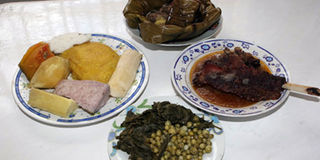Prime
Katunkuma: Keeping the blood pressure in check daily

The bitter berries are eaten along with other food. Photo by Ismail Kezaala.
What you need to know:
Katunkuma is eaten by most tribes in Uganda despite the fact that its bitterness drives away many would be consumers. Today, it is popular especially for its medicinal value.
When she was growing up, Christine Mukidi, who is in her 50s, says katunkuma was regularly eaten as the main sauce, a practice that still exists today in some parts of the country. So was it for lack of alternatives that katunkuma was used as sauce, I ask Mukidi.
No, she says, it was considered very ordinary just like groundnut sauce, meat or beans.
Today, however, the fruit is majorly eaten for the medicinal value attached to it, and it is almost obvious that when you see anyone eating katunkuma regularly, then it could be that they are either fighting high blood pressure or diabetes. This also makes it a rarity on many menus because it’s not a favourite for many people. Consequently, it does not have good and ready market in comparison to other vegetables like say, dodo and nakati, so you will only find a few people selling katunkuma in the market.
Medicinal value
Samuel Kalibbala, a naturopathic expert who works with Dama Medicinal Herbs on Mukwano Complex, says although not a food many people would think of adding to their plates even if it were available, katunkuma has a high nutritional value that makes it an immune booster even for children and the elderly who are prone to diseases.
“It also normalises blood pressure, has a cleansing/purifying effect on blood and also helps with the functioning of the kidneys,” he says.
Botanically known as Solanum Indicum, Kalibbala explains that this bitter fruit has chemicals that deal with the cholesterol in the blood, preventing it from piling in your blood vessels which could result in high blood pressure, strokes, or diabetes.
“These chemicals will dissolve the fat in the blood such that blood moves more smoothly through your vessels giving you a normal heart rate. Otherwise, with fat lining your vessels, the heart will need excess force to pump blood around your body which could lead to high blood pressure.”
At Dama, the fruit is dried (away from the sun to maintain its nutritional content), pounded and ground into a powder which goes for Shs6,000 for a 200g tin, and Kalibbala says the powder can then be mixed with any food/sauce of your choice when it has been served.
He also recommends that katunkuma is better eaten when raw because this is when it has a high nutritional value unlike when it cooked. Much as many people would rather eat ntula (egg plants) Kalibbala thinks that these are a hybrid developed from katunkuma which is much more nutritious than the latter.
How it is cooked
Mukidi says that in those days, as sauce, katunkuma would be put in a banana leaf and steamed on top of food ( matooke).
“And when the food was ready, the katunkuma would be quickly mashed and mixed with boiled water. A little salt to taste and your katunkuma sauce would be ready to serve with your tooke, muwogo or lumonde. Sometimes, it would steamed, still on top of the food, together with dodo or nakati and they would be eaten together as vegetables to accompany the main sauce of beans or fish,” Mukidi explains.
For its medical value, Mukidi says you can cook it with groundnuts although people who find it bitter may be unable to eat that kind of sauce.
Although it has been with us for a long time, the medicinal value attached to it is slowly giving it a new face.




